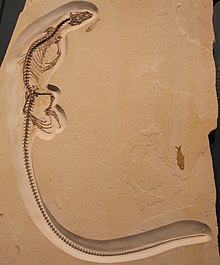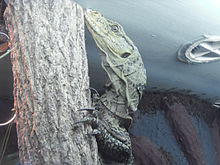Varanidae
| Varanids | |
|---|---|

| |
| MaleKomodo dragons(Varanuskomodoensis) fighting,Indonesia | |

| |
| Fossil ofSaniwa,an extinct varanid known from theEoceneof North America | |
| Scientific classification | |
| Domain: | Eukaryota |
| Kingdom: | Animalia |
| Phylum: | Chordata |
| Class: | Reptilia |
| Order: | Squamata |
| Superfamily: | Varanoidea |
| Family: | Varanidae Merrem,1820 |
| Genera | |
TheVaranidaeare afamilyoflizardsin thesuperfamilyVaranoideaand orderAnguimorpha.The family, a group ofcarnivorousandfrugivorouslizards,[1]includes the livinggenusVaranusand a number of extinct genera more closely related toVaranusthan to theearless monitor lizard(Lanthanotus).[2]Varanusincludes theKomodo dragon(the largest living lizard),crocodile monitor,savannah monitor,thegoannasof Australia and Southeast Asia, and various other species with a similarly distinctive appearance. Their closest living relatives are theearless monitor lizardandChinese crocodile lizard.[3]The oldest members of the family are known from theLate Cretaceousof Mongolia.[2]
Taxonomy[edit]
The Varanidae were defined (using morphological characteristics) by Estes, de Queiroz and Gauthier (1988) as the clade containing the most recent common ancestor ofLanthanotusandVaranusand all of its descendants.[4]A similar definition was formulated by Conradet al.(2008) (also using morphological data), who defined the Varanidae as the clade containingVaranus varius,Lanthanotus borneensis,and all descendants of their last common ancestor.[5]Using one of these definitions leads to the inclusion of the earless monitor lizard (L. borneensis) in the family Varanidae.
Lee (1997) created a different definition of the Varanidae, defining them as the clade containingVaranusand all taxa more closely related toVaranusthan toLanthanotus;[6][7]this definition explicitly excludes theearless monitor lizardfrom the Varanidae. WhetherL. borneensisis included in or excluded from the Varanidae depends on the author; for example, Vidalet al.(2012) classify the earless monitor lizard as a member of a separate familyLanthanotidae,[8]while Gauthieret al.(2012) classify it as a member of Varanidae.[9]
Genera[edit]
- Genera marked with†areextinct
Generaincluded in Varanidae according to Donget al.,2022[2]
- †OvooNorell, Gao, & Conrad, 2008[10](Mongolia, Late Cretaceous)
- †AiolosaurusGao and Norell, 2000[10](Mongolia, Late Cretaceous)
- †CherminotusBorsuk-Bialynicka, 1984(Mongolia, Late Cretaceous)
- †SaniwidesBorsuk-Bialynicka, 1984(Mongolia, Late Cretaceous)
- †ParavaranusBorsuk-Bialynicka, 1984(Mongolia, Late Cretaceous)
- †ProplatynotiaBorsuk-Bialynicka, 1984(Mongolia, Late Cretaceous)
- †TelmasaurusGilmore, 1943[10](Mongolia, Late Cretaceous)
- †SaniwaLeidy, 1870(Europe, North America,Eocene)
- †ArchaeovaranusDonget al.,2022 (China, Eocene)
- VaranusShaw, 1790
Phylogeny[edit]
Below is acladogramfrom Dong et al. 2022.[2]
| Varanidae | |
Biology[edit]

Monitor lizards are reputed to be among the most intelligent lizards. Most speciesforagewidely and have large home ranges,[11]and many have high stamina.[12]Although most species are carnivorous, threearborealspecies in thePhilippines(Varanus olivaceus,Varanus mabitang,andVaranus bitatawa) are primarily frugivores.[1][13]Among species of living varanids, the limbs show positiveallometry,being larger in larger-bodied species, although the feet become smaller as compared with the lengths of the other limb segments.[14]
Varanids possess unidirectional pulmonary airflow, includingair-sacsakin to those of birds.[15]
See also[edit]
References[edit]
- ^abWelton LJ, Siler CD, Bennett D, Diesmos A, Duya MR, Dugay R, et al. (October 2010)."A spectacular new Philippine monitor lizard reveals a hidden biogeographic boundary and a novel flagship species for conservation".Biology Letters.6(5): 654–658.doi:10.1098/rsbl.2010.0119.PMC2936141.PMID20375042.
- ^abcdDong L, Wang YQ, Zhao Q, Vasilyan D, Wang Y, Evans SE (March 2022)."A new stem-varanid lizard (Reptilia, Squamata) from the early Eocene of China".Philosophical Transactions of the Royal Society of London. Series B, Biological Sciences.377(1847): 20210041.doi:10.1098/rstb.2021.0041.PMC8819366.PMID35125002.
- ^Fry BG, Vidal N, Norman JA, Vonk FJ, Scheib H, Ramjan SF, et al. (February 2006). "Early evolution of the venom system in lizards and snakes".Nature.439(7076): 584–588.Bibcode:2006Natur.439..584F.doi:10.1038/nature04328.PMID16292255.S2CID4386245.
- ^de Queiroz K, Gauthier J (1988). "Phylogenetic Relationships within Squamata". In Estes RJ, Pregill GK (eds.).Phylogenetic Relationships of the Lizard Families: Essays Commemorating Charles L. Camp.Stanford University Press. p. 166.ISBN9780804714358.OCLC16646258.
- ^Conrad J (2008). "Phylogeny and systematics of Squamata (Reptilia) based on morphology".Bulletin of the American Museum of Natural History.310:1–182.doi:10.1206/310.1.hdl:2246/5915.S2CID85271610.
- ^Warner R (June 1946)."Pectoral Girdles vs. Hyobranchia in the Snake Genera Liotyphlops and Anomalepis".Science.103(2686). The Royal Society: 720–722.Bibcode:1997RSPTB.352...53L.doi:10.1098/rstb.1997.0005.PMC1691912.
- ^Lee MS (June 2005)."Molecular evidence and marine snake origins".Biology Letters.1(2): 227–230.doi:10.1098/rsbl.2004.0282.PMC1626205.PMID17148173.
- ^Vidal N, Marin J, Sassi J, Battistuzzi FU, Donnellan S, Fitch AJ, et al. (October 2012)."Molecular evidence for an Asian origin of monitor lizards followed by Tertiary dispersals to Africa and Australasia".Biology Letters.8(5): 853–855.doi:10.1098/rsbl.2012.0460.PMC3441001.PMID22809723.
- ^Gauthier JA, Kearney M, Maisano JA, Rieppel O, Behlke AD (2012). "Assembling the Squamate Tree of Life: Perspectives from the Phenotype and the Fossil Record".Bulletin of the Peabody Museum of Natural History.53(1): 3–308.doi:10.3374/014.053.0101.S2CID86355757.
- ^abcConrad JL, Balcarcel AM, Mehling CM (2012)."Earliest example of a giant monitor lizard (Varanus, Varanidae, Squamata)".PLOS ONE.7(8): e41767.Bibcode:2012PLoSO...741767C.doi:10.1371/journal.pone.0041767.PMC3416840.PMID22900001.
- ^Perry G,Garland Jr T(2002)."Lizard home ranges revisited: effects of sex, body size, diet, habitat, and phylogeny"(PDF).Ecology.83(7): 1870–1885.doi:10.1890/0012-9658(2002)083[1870:LHRREO]2.0.CO;2.
- ^Clemente CJ, Withers PC, Thompson GG (2009)."Metabolic rate and endurance capacity in Australian varanid lizards (Squamata; Varanidae;Varanus) ".Biological Journal of the Linnean Society.97(3): 664–676.doi:10.1111/j.1095-8312.2009.01207.x.
- ^Greene HW (1986).Diet and Arboreality in the Emerald Monitor, Varanus prasinus, with Comments on the Study of Adaptation.Chicago: Field Museum of Natural History.OCLC14915452.OL7155983M.
- ^Christian A,Garland Jr T(1996)."Scaling of limb proportions in monitor lizards (Squamata: Varanidae)"(PDF).Journal of Herpetology.30(2): 219–230.doi:10.2307/1565513.JSTOR1565513.
- ^Unidirectional Airflow In The Lungs Of Birds, Crocs And Now Monitor Lizards
